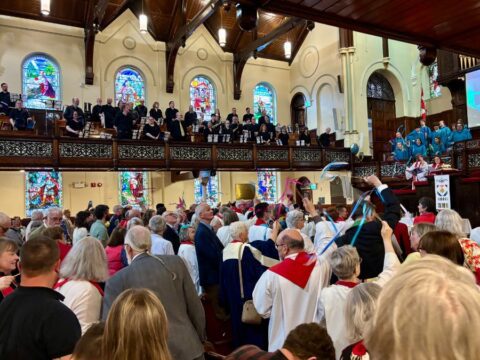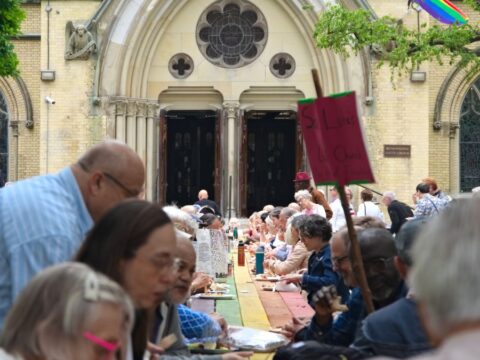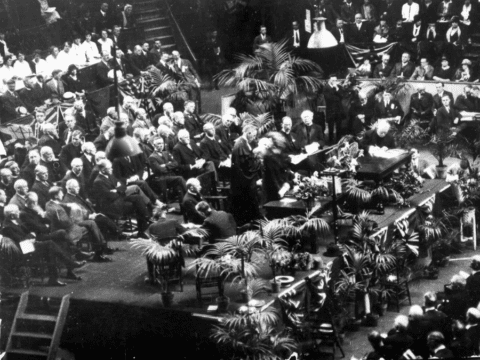From the porch of our log-cabin home at the base of Vancouver Island’s Beaufort Mountain Range, the only living creatures my wife, Christina Bogucki, and I see are birds and animals. This solitude is a stark contrast to the busy, public experience of touring.
Over the past 40 years, my musical ministry has taken me to at least 2,000 United churches, meetings in nearly all of our Conferences, numerous General Councils and on over 80 cross-country road trips.
From August 2012 to June 2013, I did one last tour — the Tour of a Lifetime. I didn’t really want to retire from touring, but the state of the church, escalating costs and age seemed to dictate the timing. This tour covered over 50,000 kilometres by surface, air and water, from west to east and back again, through 10 provinces and two territories. It was invigorating, exhausting, emotional — and a chance to reconnect with people and places.
My tour partners were the Canadian Foodgrains Bank and The United Church Observer — raising funds for CFGB and circulation for The Observer. The support team included tour managers Lorraine and Clay Thompson, choir director Lonnie Moddle, communications manager Phyllis Thompson, and Christina as technical and administrative manager. Time and again, host churches commented on our “well-oiled machine.”
Countless times, I was asked, “So, how is the church doing?” Many people were likely seeking affirmation of what they had read, heard or were experiencing first-hand. Some clearly hoped I could tell them that it was better someplace else.
Let me be clear: I love The United Church of Canada. It has been home to me for nearly 45 years. I have served several other denominations in both Canada and the United States, but no church has fit me as well. Witnessing what is happening to the church now is as painful as sitting helplessly at the bedside of a dying friend.
My comments are personal opinions and observations, based on visits to 126 selected congregations over a year. But members of nearly 400 other United Church congregations, plus people from other denominations, also attended Tour of a Lifetime workshops and concerts.
People were there by choice and interested in what we had to offer. We were only involved in one Sunday-morning service during the tour. With those caveats, I offer some thoughts and a few preachy conclusions.
We are not alone. The United Church of Canada clearly holds no monopoly on decreasing numbers. The malaise gripping the 21st-century church is more cultural than denominational. United Church people need to recognize this reality. While travelling, I heard a tendency to beat ourselves up, blaming some aspect or position of the national church for the lack of attendance or engagement in local congregations.
Many declining congregations are exploring amalgamations within the denomination, and others will soon be nudged to consider cross-denominational amalgamations. Churches unwilling to engage in this kind of exploration will simply, albeit painfully, die. Perhaps those of us who lean toward ecumenism can find some hope or solace in the current changes.
We are not a “united” church, so calling ourselves that seems paradoxical. Personally, I much prefer the active, dynamic term “uniting” (as in the Uniting Church in Australia).
The visionary freedom that must have been part of the 1925 union seems to have morphed into a cumbersome institution, which has sacrificed its relevance to the very people it wishes to support and evangelize.
Our buildings have become an impediment to ministry. In countless congregations, attachment to physical structures has unfortunately become the touchstone for our identity. Spending precious and shrinking resources maintaining and repairing old buildings is poor stewardship.
It’s past time to consider divesting assets that no longer serve us well. The design of many older buildings just doesn’t work in our present context. I heard many creative ideas that were deemed impossible because of existing architecture.
Many of our buildings are no longer physically welcoming. They are tired-looking and virtually impossible to keep clean. Beautiful, solid wooden doors often intimidate strangers. Once through those doors, people should experience human contact as quickly as possible, not signs and arrows pointing to the “Office.”
Our buildings need to be multi-purpose resources. It was exciting to see one Alberta church that was sharing space with the community’s municipal offices. There was life inside, with a constant flow of people.
When my home church did a major, creative renovation 10 years ago, we spent almost a year worshipping in the showroom of a local car dealership. During that time, our membership grew.
Another observation from touring is that creative theological probing by lay people, with encouragement and guidance by order-of-ministry leaders, is occurring at an unprecedented level. Elders are leading the way. Across Canada, study groups examining what is popularly branded “progressive theology” are proliferating.
Ironically, amid these theological discoveries we are facing extinction. Imagine what could be birthed and brought to fruition if the resources currently being invested in survival were available for creativity.
Generally speaking, children’s, youth and family ministries are struggling. Most of the churches where we witnessed active participation in children’s and youth programs had intentionally invested in those ministries, often hiring full-time personnel. There was almost universal agreement about the importance of ministry for children, youth and families. However, when it came to financial investment in personnel, not so much.
The disconnect between what happens inside and outside church is not only experienced by youth. We used to ask where the youth were. Then it was 30- and 40-year-olds. Now, I believe, very few people under 60 are willing to risk connection with the church.
Today’s “church” is in Tim Hortons, Starbucks and even McDonald’s. I see the congregation assembled there every time I enter. They’re drinking and eating, sharing and conversing, listening and helping each other. What can churches learn from that?
I would be remiss if I didn’t comment on the state of music in our church. I was impressed with the commitment of music leaders across the land. It has to be one of the most demanding facets of ministry, balancing respect for traditional hymnody and openness to new expressions.
The United Church sings its faith like few other denominations. The fact that we are not really united, coupled with our broad theological spectrum, makes choosing music for worship incredibly challenging. For some, musical excellence is both a spiritual and artistic goal. For others, the raggedy-band style of “everyone can sing” is the ultimate community expression of faith.
I believe we need a new model for music leadership. I like singer-songwriter Linnea Good’s use of the term “music animator.” It’s almost impossible to find music leaders who are capable and competent in a variety of idioms and on a variety of instruments. Perhaps leaders need to be seen as enablers as well as musicians.
When I left Knox United in Parksville, B.C., after more than a dozen years, we had a team: me at the piano, plus an organist, senior and junior choir director, percussionist, bass player, guitarist, violinist and one person who played guitar, banjo, tenor sax and light percussion. There was little the congregation wanted that at least one of us wasn’t able to deliver. One person was in charge, but we were truly a ministry team and a model for what can be.
Without question, the most popular piece of music on the tour was Deep in Our Hearts. Choirs and congregations inside and outside the United Church know this simple song about common longing, vision and purpose. Yet, this song that resonates with so many people in worship settings is not a hymn, does not mention Jesus or God, and has words written by a defrocked United Church minister.
I’m not giving up on our uniting church. In some ways, I love it more than ever. I do not believe it needs to become another historical relic.
My signature piece for decades was a paraphrased setting of Psalm 113 titled Praise to the Lord, which I wrote in 1971. For years, every concert either started or ended with it. I still love the music, but did not play or sing it once during the Tour of a Lifetime. I felt that doing so might have unfairly pushed a nostalgia button.
Furthermore, I can no longer sing that piece with a sense of theological integrity. I’m grateful that many people continue to use it, partly because it’s become kind of a “heritage hymn” and partly because we’re all in different places on the journey.
For me, though, I need to move on.
***
This story first appeared in The United Church Observer’s March 2014 issue with the title “‘So, how is the church doing?’”















